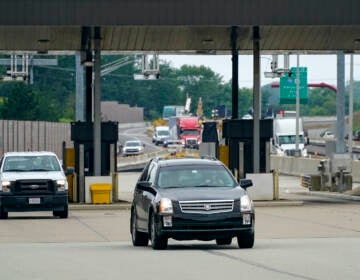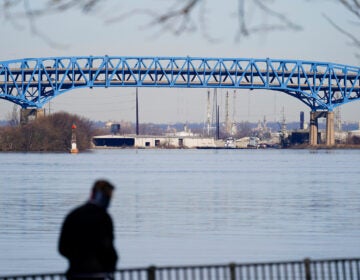Congestion pricing floated as fix for Pa. transit funding crisis
Once politically impossible even in wealthy and transit-inclined Manhattan, congestion pricing is a relatively radical idea for car-centric Philly.

A view of the Philadelphia skyline from the 52nd Street station on the Market-Frankford elevated line in West Philadelphia. (Emma Lee/WHYY)
This article originally appeared on PlanPhilly.
—
The news that New York will become the first U.S. city to impose a fee on vehicles entering Manhattan has put congestion pricing at the center of a statewide conversation about how to fill Pennsylvania’s looming $450 million-a-year transit funding hole.
The policy of charging vehicles for traveling into or within a certain area of a city at certain times has surfaced before in Philly as a means to encourage transit use while raising needed public funds. But the concept — politically impossible even in wealthy and transit-inclined New York until now — has never gained traction beyond the think tank crowd.
London, Singapore, and Sweden implemented congestion pricing and have seen clearer roads, and less pollution, according to reports. With New York offering a closer case study, Philadelphia officials now say the idea merits exploration.
“We’ll be watching NYC’s experience with congestion pricing closely to see how this can help improve equity, safety, sustainability, and mobility,” said Kelly Cofrancisco, a spokeswoman for the city.
Charging vehicles to enter parts of the city would be a major change in approach in Philly, where auto-centric thinking still guides many decisions ranging from parking minimums to a barebones approach to street sweeping shaped by complaints by drivers about moving their cars.
City Councilman Kenyatta Johnson said he is watching the Big Apple with an eye to how the fee revenue could be used.
“When you look at mass transportation, when you look at our bridge and our infrastructure — they are key areas that need support and so I’ll keep an open mind,” Johnson said.
It took more than a decade of heated public debate to get a congestion pricing plan approved by New York lawmakers. Under the plan passed Sunday in Albany, the fees are not expected to kick in until 2021 and a panel of experts will determine the amount charged guided by a goal of collecting $1 billion annually.
New York’s move coincided with the release of a report from a panel of Pennsylvania officials and business leaders outlining new approaches for funding public transportation in the Commonwealth.
The Pennsylvania Turnpike Commission contributes $450 million to public transportation in the state. But those payments will drop to $50 million after 2022 and are now threatened by a lawsuit pending in federal court challenging the constitutionality of using toll revenue to support transit.
The report suggested congestion pricing as one way to make up the difference. It would generate at least $200 million.
“We need to find new ways to fund transportation,” said Paul Levy, executive director of the Center City District and a member of the panel that assembled the report. “It is premature at this point to be in favor or opposed to any particular option. The best thing we can do is look at all options because we really need effective highways and a really good public transit system.”
Levy stressed the need for metropolitan regions to be “more self-reliant in a period of time when Washington and Harrisburg have less money to provide to us.”
Ben She, transit committee chair for 5th Square, a non-partisan, urbanist political action committee, said congestion pricing could benefit a hemorrhaging SEPTA, and deter people from driving.
“We can’t only rely on incentives for people to use only public transportation or alternatives like walking or biking,” She said. “We also really need a strong disincentive for people to stop driving everywhere.”
Philadelphia is getting more congested by the day with more vehicles — including a growing number of ride-hailing cars and delivery trucks — competing for space in a growing city.
A 2018 report by INRIX, a company that specializes in traffic analysis, ranked the city as the 9th most congested in the nation, with drivers spending 112 hours in congestion annually at a cost of $1,600.
The number of people sharing the road is likely to continue to grow. More than 92,000 people made Philadelphia home between 2006 and 2017, according to a Pew report.
City Council recently passed a resolution that would allow voters to decide whether or not the city creates public safety enforcement officers tasked with traffic and quality of life enforcement.
If passed, the officers would be sent to Center City, University City, Manayunk, and other high-traffic areas.
The measure will be on May’s ballot for the primaries.
WHYY is your source for fact-based, in-depth journalism and information. As a nonprofit organization, we rely on financial support from readers like you. Please give today.







